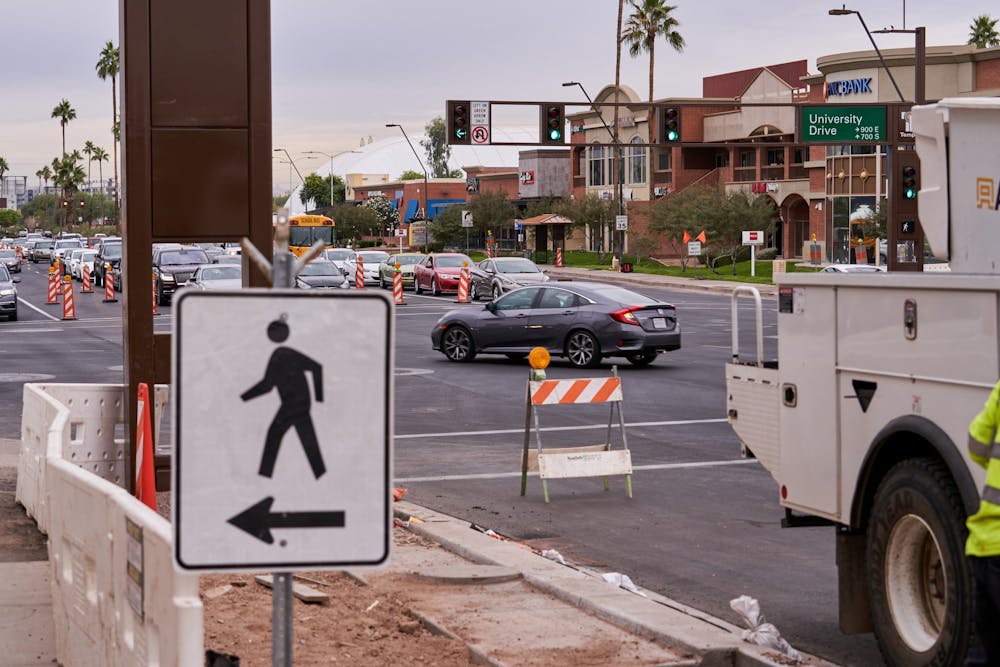Several construction projects planned by the city of Tempe and ASU have caused major frustrations and delays for many in the community who commute to campus.
In May, Tempe announced an "intersection improvement plan" on Rural Road and University Drive, which was slated to be completed in about seven months. The project aims to "increase capacity and enhance safety" as well as construct additional turn lanes, new traffic signals, updated sidewalk ramps and improved transit stop. According to TaiAnna Yee, a Tempe spokesperson, the construction should conclude by mid-December.
In December 2020 not far from Tempe's road work, the University began construction for a pedestrian bridge to connect the Novus Innovation Corridor with the ASU campus and the new Interdisciplinary Science and Technology Building 7. Both ASU projects are to be completed in December 2021, according to the University.
Ashley Juban, a junior majoring in supply chain management, lives in north Chandler which is about a 17-minute drive from the Tempe campus. She passes through the construction site on her commute to school and has to drive through the blocked intersection multiple times a day, which adds around 10 to 20 minutes to her drive, she said.
"Coming from Chandler up to Rural is the most annoying because as soon as I get off the freeway, there's already construction and cones everywhere," Juban said.
Even after arriving on campus for school, Juban still has to deal with driving on University Drive to get to her part-time job at i-Tea.
"Commuting from work to school is even worse than commuting from home to school," Juban said. "Let's say I have a morning shift at i-Tea, and then go to campus afterward. There's like twice, three times as much traffic as there is going to i-Tea from campus."
Some ASU staff members have also struggled with commuting to work due to the unpredictable road closures surrounding the University. Zehra Hodzic, a research analyst at the School of Earth and Space Exploration, said "every major street surrounding ASU is so bad."
"They're changing things so frequently, you don't even know which lanes are going to be closed off ahead of time. So it's not like you can prepare ahead of time and find a re-routed version of how to get to your location," Hodzic said.
Hodzic works five days a week from 7 a.m. to 4 p.m. and experiences delays every day. She says her evening commute back home to Central Phoenix is sometimes worse than her morning commute to campus.
"Normally, it takes me about 15 to 20 minutes to get from my place to campus," Hodzic said. "But if you add on all the lane blocks, construction and afternoon traffic, it doubles the amount of time it takes for me to get home, which is just ridiculous."
In an email, Yee said to combat frustrations with the construction, the city of Tempe encourages commuters to use alternative methods of transportation, such as the bus or the light rail, to get to their destinations.
"The city understands that construction can be frustrating and we apologize for any inconvenience it may cause," Yee said. "We do try and limit construction on our streets as much as possible, but due to safety concerns, we may have to leave barricades in place 24/7. We do have a strong multi-modal transportation system, with bike lanes and bus routes on many of our streets and we encourage alternative transportation use as much as possible."
According to Jack Donahue, a mechanical foreman at Williamson Development in Peoria, frustration towards road work is very common. However, closures are necessary to complete renovations and improvements.
"The reason that lane closures on one site can be unpredictable is because when we dig into the street, it's done in shifts," Donahue said. "We will chop up the earth there, dig down and fix that portion, then open it up again the next day for a work order."
Donahue said although the extra commute time may be frustrating, drivers should slow down in construction zones and pay attention to signage in order to keep workers, pedestrians and drivers safe.
"I've seen people hit our barricades and drive by," Donahue said. "Please remember that it's a human life standing there trying to make a living."
Reach the reporter at rkalale@asu.edu and follow @pokefanrithwik on Twitter.
Like The State Press on Facebook and follow @statepress on Twitter.
Continue supporting student journalism and donate to The State Press today.




